Psoriasis is one of the most common skin diseases that affects one in every hundred people.
Psoriasis is a disease in the development of which several factors are important at the same time: from hereditary predisposition (psoriasis in relatives) to dysfunction of the nervous system, endocrine system, immune system and other factors.
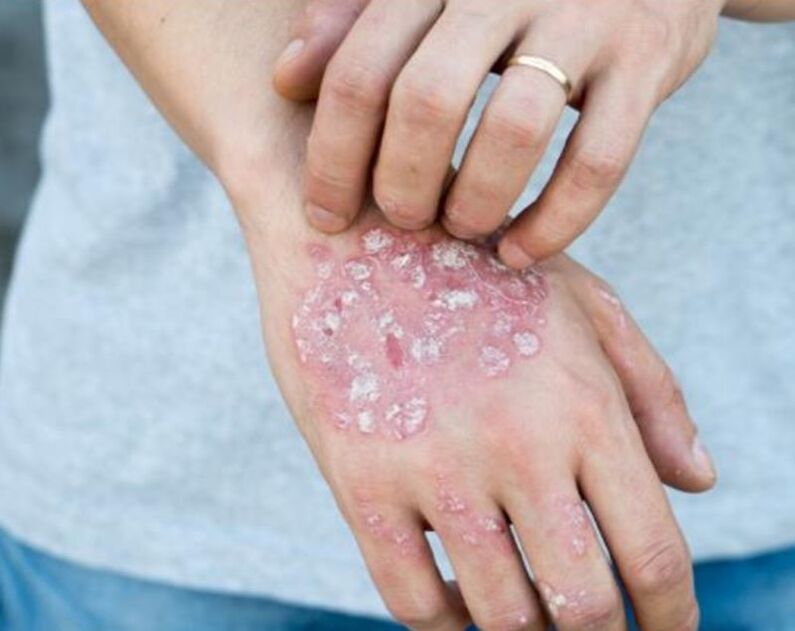
The reasons
The causes of psoriasis are not fully understood.
The principle of the mechanism of disease is to disrupt the division of skin cells, which provokes an autoimmune reaction (autoimmune reaction - occurs in the body, does not depend on external threats).
The top layer of skin (epidermis) consists mainly of keratinocytes - cells that produce keratin. Keratin is a protein whose properties make it possible to fulfill the protective function of the skin. Keratinocytes form in the deep layers of the epidermis and slowly move to its surface. As they move, they mature and acquire new properties.
At the end of their "maturation", keratinocytes form a stratum corneum on the surface of the skin. Then the keratinized cells die and flake off the living ones, ending the life cycle of the keratinocytes. This ensures continuous skin renewal.
The normal journey of the keratinocytes from the deep layer to the surface takes a month. With psoriasis, their lifespan is shortened to several days. This leads to the appearance of scaly patches of psoriasis, as the skin does not have time to get rid of keratinized cells.
When they do appear, psoriatic plaques are usually accompanied by itching and redness. This indicates an autoimmune reaction in the deep layers of the skin causing swelling of the thick layer of skin (dermis). The dermis contains blood and lymph vessels.
It is not certain why the process of keratinocyte formation is accelerated, but a hereditary factor is known to play a significant role.
Common psoriasis may begin to develop due to:
- mental trauma and constant states of stress;
- Damage to the skin;
- transmitted infectious disease;
- are taking some medication;
- hormonal disorders;
- allergic reactions (typical allergens: citrus fruits, eggs, chocolate);
- Alcohol poisoning;
- Climate change.
The psoriasis triad is a characteristic symptom of the disease that occurs when the skin is scraped off.
Stearin stain(Increased peeling after scraping, making the surface of the papules resemble a crushed drop of stearin).
Thermal film(the appearance of a wet, thin, shiny, translucent surface after complete removal of the scales).
Precise bleeding(the appearance of drops of blood that do not merge with each other).
What happens to the skin in psoriasis?
In psoriasis, the structure of the skin is disrupted, the epidermis becomes thinner, the processes of keratinization of the skin (accumulation of keratin protein) are disrupted, and some layers of the normal epidermis disappear. In the next stage of the disease, the cell clusters responsible for inflammation are located in the protective superficial stratum corneum of the epidermis and in the parakeratosis zone around the enlarged skin vessels.
Characteristic plaques and scales appear on the surface of the skin.
Not only is psoriasis a common disease, it has many forms and even disguises itself as other diseases.
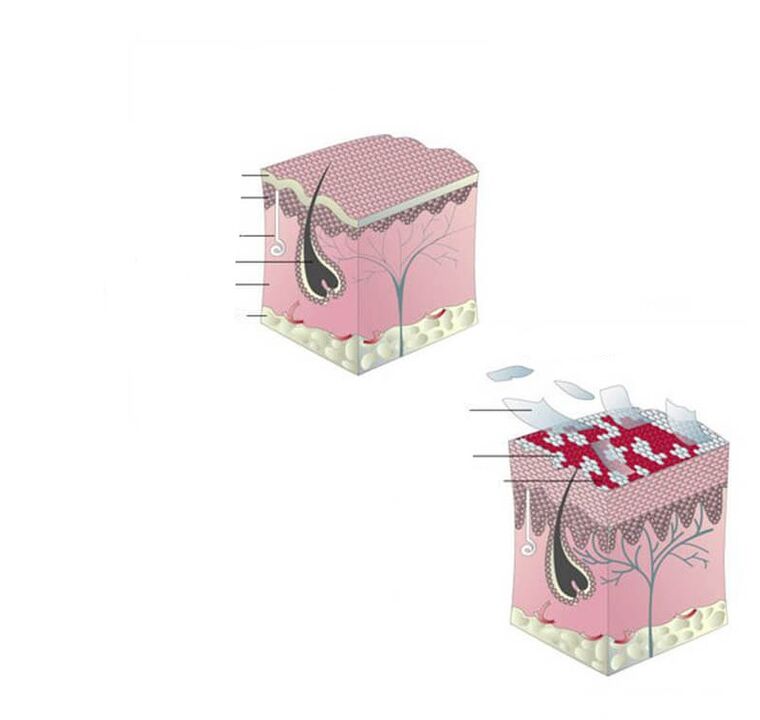
Localization sites of psoriasis:
- Elbows and knees;
- Sacrum and loin;
- Scalp (seborrheic psoriasis);
- Flexion surfaces and skin folds: the inner surface of the elbow and knee joints, the groin and armpits, the area under the chest (inverse psoriasis);
- Palms and surfaces of the feet (palmar-plantar psoriasis);
- Psoriasis of the nail plates.
Common symptoms of psoriasis
The main symptoms of psoriasis are:
- Psoriatic plaques;
- Tightness of the affected skin area;
- Itching.
Symptoms by type of psoriasis:
- exudative psoriasis (the affected areas of the skin peel and get wet, a yellow crust forms on the surface of the rash);
- intertriginous psoriasis (more often in children the foci of appearance are red, with a slight peeling, sometimes moist can be mistaken for diaper rash);
- ancient psoriasis (it is characterized by large plaques that do not go away for a long time);
- Rupioid psoriasis (another form of chronic psoriasis characterized by a cone-shaped plaque);
- guttate psoriasis (severe rash of small papules).
Types of psoriasis
- Psoriasis common (vulgar, plaque);
- Generalized psoriasis (widespread, postular);
- Psoriasis drop-shaped (according to the type of rash);
- Arthropathic psoriasis (with joint damage);
- Other types of psoriasis (seborrheic and others).
Psoriasis vulgaris is the most common form of the disease.
Psoriasis begins with the appearance of often a few skin rashes in typical places: on the elbows and knees. The characteristic localization of the rash is also the area of the scalp and trunk. Usually there is a clear correlation between the appearance of rashes and the effect of the provoking factor.
The provoking factors in psoriasis can be stress, skin trauma, a recent infectious disease, and regular alcohol consumption.
Usually the exacerbation of the disease occurs in the cold season - this is the winter type of psoriasis. The summer type is less common. Mixed forms of psoriasis are now identified. Over time, the number of rashes increases. They form characteristic psoriasis plaques. The Kebner phenomenon is observed - the appearance of new plaques in places with skin trauma. As a rule, patients have plaques that remain on the skin even without an exacerbation.
The disease flows cyclically:
- Progressive stage (increase in the number of rashes);
- Stationary stage (new rashes do not appear);
- Regression stage (regression of rashes, appearance of areas of skin in their place without pigment).
Psoriasis vulgaris, photo
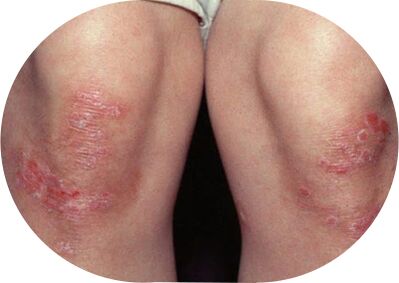
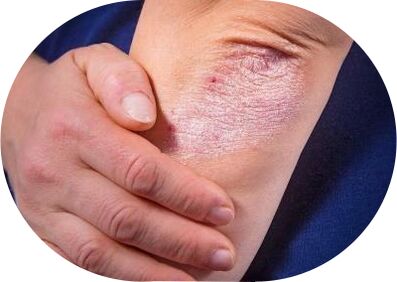
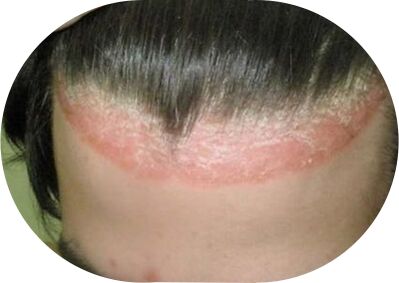
diagnosis
When diagnosing psoriasis, the first thing that is necessary is a detailed examination of the skin.
Thin skin, bleeding in places, loose plaques are signs of psoriasis. If these symptoms are present, the doctor will conduct a series of diagnostic measures aimed at excluding the presence of other events with similar manifestations. Blood tests, swabs, and skin biopsies will be done as needed for the final diagnosis. If the joints are affected, magnetic resonance imaging (MRI) is prescribed and x-rays are taken to identify lesions.
Psoriasis vulgaris, treatment
Psoriasis is a systemic disease with skin manifestations, and complex treatment is required: both local and systemic therapy. The disease is chronic and treatment is aimed at reducing the number and severity of exacerbations and achieving a skin condition that is acceptable to the patient.
As psoriasis progresses, all aggressive procedures are broken off: UV radiation, baths. It is important that patients with psoriasis treat the skin carefully and carefully, and not injure it, to avoid aggravation and the appearance of new plaques.
Diet against psoriasis
Often psoriasis is associated with liver disease, so it is important to avoid alcohol, fatty, fried, and smoked foods. Moderate carbohydrate intake is equally important as it changes the pH of the skin and increases the risk of the rash becoming infected.
prophylaxis
Psoriasis prevention is about maintaining a healthy lifestyle. This helps prevent other diseases from occurring because the body's immune system is protected from stress and can withstand external threats.
Measures to prevent psoriasis include:
- appropriate skin care;
- relaxing massage to improve blood circulation;
- With proper nutrition, it is advisable to avoid allergenic foods and to exclude (limit) the intake of spicy, fatty, pickled, smoked, salty foods as well as citrus fruits.
- Milk and vegetable diet;
- a sufficient amount of moisture in the body;
- Elimination of alcohol and smoking and other bad habits;
- increased physical activity;
- goes outdoors;
- Avoidance of stressful situations;
- Taking vitamins of groups A, B, C, D, E;
- Choosing loose clothing made from natural materials that will not chafe and cause irritation.
Means for treating psoriasis
Systemic therapy for psoriasis aims to reduce the proliferation of the skin epithelium and stabilize the keratinization of skin cells and cell membranes. For this purpose, preparations based on vitamin A (retinoids) and cytostatics are used. The most modern treatments use so-called biologicals that neutralize anti-inflammatory substances.
For many years, UFOs have been used - treatment with ultraviolet rays of group B (in tanning beds, rays of group A), which reduce inflammation and contribute to the death of altered cells. PUVA therapy is the simultaneous application of ultraviolet radiation and a special substance that increases the sensitivity of the skin to it.
An effective remedy for psoriasis
Local treatment is no less important than systemic treatment. It helps reduce skin inflammation. The drugs are prescribed depending on the stage of psoriasis.
Progressive phase
- Exfoliating ointments and lotions;
- anti-inflammatory hormonal ointments with calcitriol;
- Emollient against itching and dry skin.
Stationary stage
- UVB therapy;
- concentrated peeling ointments;
- Emollients to restore the skin and reduce dryness.
Regressive phase
- concentrated peeling ointments;
- Emollients to restore the skin and reduce dryness.
Psoriasis cream
Creams and ointments for psoriasis have different purposes and are used at different stages of the disease. Hormonal anti-inflammatory ointments and creams are used to stop inflammatory processes in the skin. There are different classes of hormones. They have different absorption capacities and different activities. When used in children, try to avoid using hormonal drugs on the face and neck area, the area of the folds of the skin - places where the skin is thinner. Local preparations based on calcipotriol (a vitamin D derivative) also have an anti-inflammatory effect. This is a later generation of drugs. They are currently not used during pregnancy and breastfeeding.
Salicylic ointment and salicylic acid lotion are designed to remove flaky skin that has dandruff. Salicylic acid not only has an exfoliating effect, but also increases the effectiveness of local hormonal drugs. In the stationary and regressive stage, when the inflammation has become less active, agents based on salicylic acid are used in a higher concentration.
Throughout the course of treatment, as well as in conjunction with ultraviolet radiation, means are used to restore the structure of the skin and remove dryness, in order to reduce the itching of the skin. Once the flare-ups have subsided, these products help maintain the protective properties of the skin and reduce the risk of new breakouts.
An effective cream for psoriasis
The modern approach to the care and support of dry skin is based on the saturation of the epidermis with moisture and is called corneotherapy (derived from "Corneo" - the corneal or horny layer of the epidermis).
Corneotherapy aims to restore the stratum corneum of the epidermis and its protective functions, which can improve the overall condition of the skin. The work of the founder of corneotherapy, Albert Kligman, made it possible to create special means - emollients.
How do plasticizers work?
Within 1 hour of applying emollients: - The condition of the skin improves due to the fact that emollients "lock in" moisture in it.
6 hours after applying emollients: - The structure of the skin is restored thanks to the content of special natural lipids (ceramides and other beneficial fats).
24 hours after applying emollients: - Clinical improvement in skin condition occurs when moisturizing components penetrate the deep layers of the epidermis and the surface layers of the skin are restored (up to 24 hours after the start of application). .

























